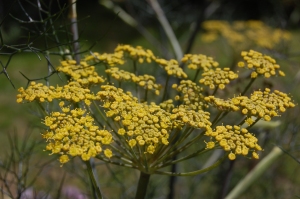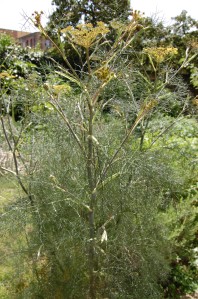Position: Full sun to partial shade
Soil: Moist, well drained soil
Flowering period: Summer
Eventual Height: 2m
Eventual Spread: 45cm
Hardiness: 4a, 4b, 5a, 5b, 6a, 6b, 7a, 7b, 8a, 8b, 9a, 9b
Family: Apiaceae (formally Umbelliferae)
Foeniculum vulgare ‘Purpureum’, commonly know as Bronze Fennel, is an semi evergreen perennial with a bushy habit. Its finely divided, aromatic, hair-like, bronze, pinnate leaves are borne upon erect branching stems. In summer it bears, flat umbels composed of hermaphroditic, small, yellow flowers. The flowers then go on to form dry seeds which are 4-10mm long, half as wide and grooved along its length.
The species, Foeniculum vulgare, commonly known as the herb Fennel, is native to the Mediterranean region although it has become naturalised in many temperate regions around the world including England. It has a large history of use both culinary and medicinal; the Azoricum Group of Foeniculum vulgare or Florence Fennel includes most of the commonly produced cultivars for culinary use, prised for their foliage, seed and inflated, bulb like leaf base. All parts of the plant have a similar flavour and aroma to aniseed. This plant has a long history of use as a medicinal plant. These include the treatment of the intestinal tract, the eyes, blood and urine and improving the supply of breast milk.
The etymological root of the binomial name Foeniculum is derived from the Latin foenum, meaning ‘hay’, in reference to its aroma. Vulgare is from the Latin, meaning ‘common’. Purpureum is from the Latin meaning ‘purple’ or a ‘deep red’.
Foeniculum vulgare ‘Purpureum’ may be useful to the landscape architect for its intriguing, fully hardy foliage, forming associations with other plants easily due to it allowing light through its canopy. It is also useful when creating low maintenance edible schemes including those for educational purposes.
The Royal Horticultural Society have given the cultivars Foeniculum vulgare ‘Amigo’, ‘Atos’, ‘Carmo’, ‘Dover’, ‘Heracles’, ‘Pronto’, ‘Victorio’ and ‘Zefa Fino’ their prestigious Award of Garden Merit.
Foeniculum vulgare ‘Purpureum’ will tolerate almost any soil conditions; it will be happy in neutral, alkaline or acid pH levels, in loam, chalk, clay or sand based soils facing a sheltered, southern or western facing aspect. There are conflicting reports on its tolerance of coastal conditions and we would welcome reader input on this matter.
Ecologically, Foeniculum vulgare ‘Purpureum’ is particularly noted for attracting pollinating insects such as butterflies and honey bees.
Foeniculum vulgare ‘Purpureum’ requires no maintenance. May be cut back to 30cm above ground after it has finished flowering, if grown primarily for its foliage the flower heads may be removed prior to opening to prevent self seeding.






Leave a comment